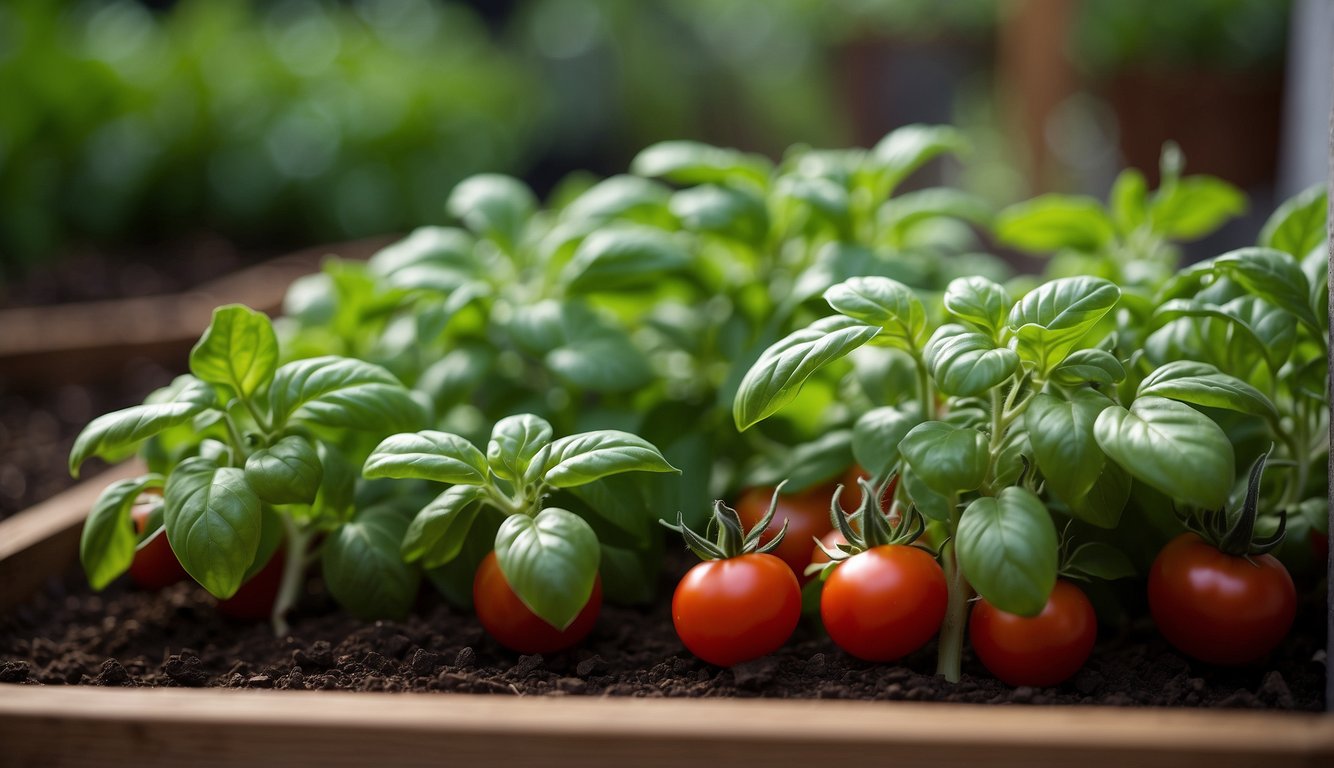TheHerbProf.com is a treasure trove of knowledge for those interested in natural healing and herbal remedies. The website is run by Paul Johnston MD. A naturopathic who has not only received extensive education in the field but also has personal experience in self-healing.
Basil and tomato companion planting is a popular and effective gardening technique that has been used for centuries. When planted together, basil and tomatoes can improve each other’s growth and flavor, and even help to repel pests. As an avid gardener myself, I have found that the combination of basil and tomatoes is not only aesthetically pleasing but also produces a bountiful harvest.
One of the main benefits of basil and tomato companion planting is the flavor enhancement. When grown together, the basil’s strong aroma can infuse the tomatoes with its delicious flavor, resulting in a more robust and flavorful tomato. In addition to flavor, planting basil with tomatoes can also help to repel pests such as thrips and tomato hornworms. Basil’s strong scent can deter these pests, which can save your tomato crop from damage.
If you are planning to start a garden or looking to improve your current one, consider planting basil and tomatoes together. Not only will they improve each other’s growth and flavor, but they are also easy to care for and require similar growing conditions. With the right care and attention, the combination of basil and tomatoes can provide a beautiful and bountiful harvest.
Benefits of Companion Planting
As a gardener, I have found that companion planting is an effective way to ensure healthy plants and a bountiful harvest. When it comes to basil and tomato companion planting, there are several benefits to consider.
Enhanced Growth and Flavor – Basil and Tomato Companion Planting
Basil and tomato plants have a natural affinity for each other. When planted together, they can enhance each other’s growth and flavor profile. Basil’s strong aroma can repel pests like aphids that can damage tomato plants, while enhancing the flavor of tomatoes when planted nearby. Additionally, tomato plants produce solanine, which deters pests from destroying both crops.
Natural Pest Control
Companion planting is an excellent way to control pests in the garden naturally. Some plants, like basil, can repel pests like aphids, squash bugs, and other insects. Other companion plants, like marigolds, can attract beneficial insects like ladybugs and lacewings, which can help control harmful pests.
Improved Pollination – Basil and Tomato Companion Planting
Pollination is a critical process in the growth and development of plants. Companion planting can help attract pollinators like bees to the garden, which can improve the pollination of both basil and tomato plants. When plants are well-pollinated, they produce more fruit and healthier plants.
Disease Prevention
Diseases can be a significant problem in the garden and can quickly spread from plant to plant. Companion planting can help prevent the spread of diseases by creating a diverse ecosystem in the garden. For example, planting basil near tomato plants can help repel pests that can spread diseases, while also attracting beneficial insects that can help control harmful pests.
In conclusion, the benefits of basil and tomato companion planting are numerous. By enhancing growth and flavor, controlling pests naturally, improving pollination, and preventing diseases, gardeners can enjoy healthy plants and a bountiful harvest.
Planning Your Companion Garden – Basil and Tomato Companion Planting
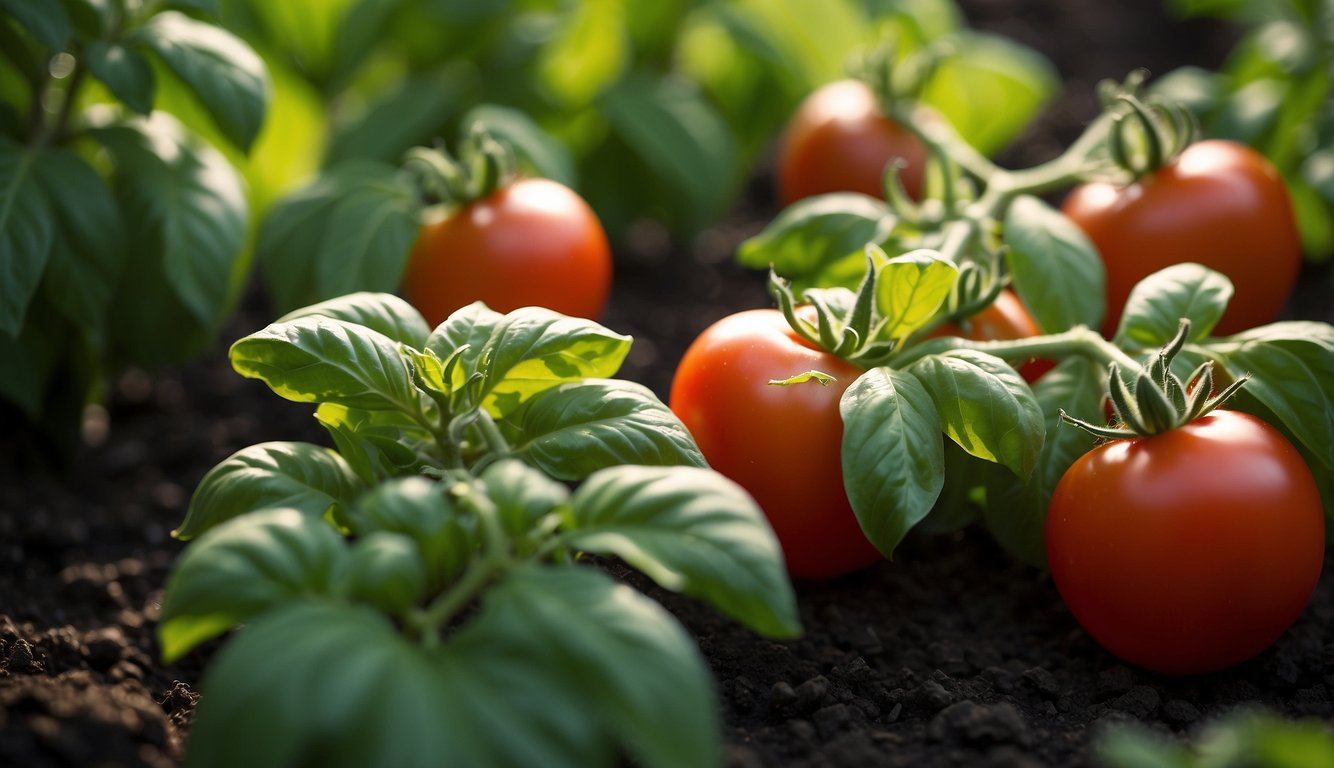
When planning a companion garden for tomatoes and basil, there are a few things to consider to ensure the plants thrive and grow well together. Here are some tips to help you plan your garden:
Garden Layout and Spacing
When planting basil with tomatoes, it’s important to consider their growth habits and spacing requirements. Tomatoes need full sun and well-drained soil, while basil prefers well-drained soil and partial shade. To accommodate these differences, you can interplant the two, placing the basil plants in the spaces between the tomato plants.
Spacing is also important to consider. Tomatoes need to be spaced about 18-24 inches apart, while basil can be planted about 12-18 inches apart. Be sure to leave enough space between the plants for good air circulation and to prevent overcrowding.
Choosing Companion Plants – Basil and Tomato Companion Planting
In addition to basil, there are several other companion plants that can benefit tomatoes in the garden. Marigolds, chives, nasturtiums, oregano, and thyme are all good choices. Marigolds, in particular, are known for their ability to repel pests and attract beneficial insects to the garden.
When choosing companion plants, it’s important to consider their growth habits and the amount of space they require. Be sure to choose plants that have similar growing requirements to your tomatoes and basil.
Plants to Avoid
While there are many plants that can benefit tomatoes and basil, there are also some plants that should be avoided. Fennel, for example, can inhibit the growth of tomatoes, while cabbage and corn can attract pests that can damage both tomatoes and basil.
By planning your companion garden carefully and choosing the right plants, you can create a thriving garden that benefits both your tomatoes and basil.
Specific Companion Planting Tips – Basil and Tomato Companion Planting
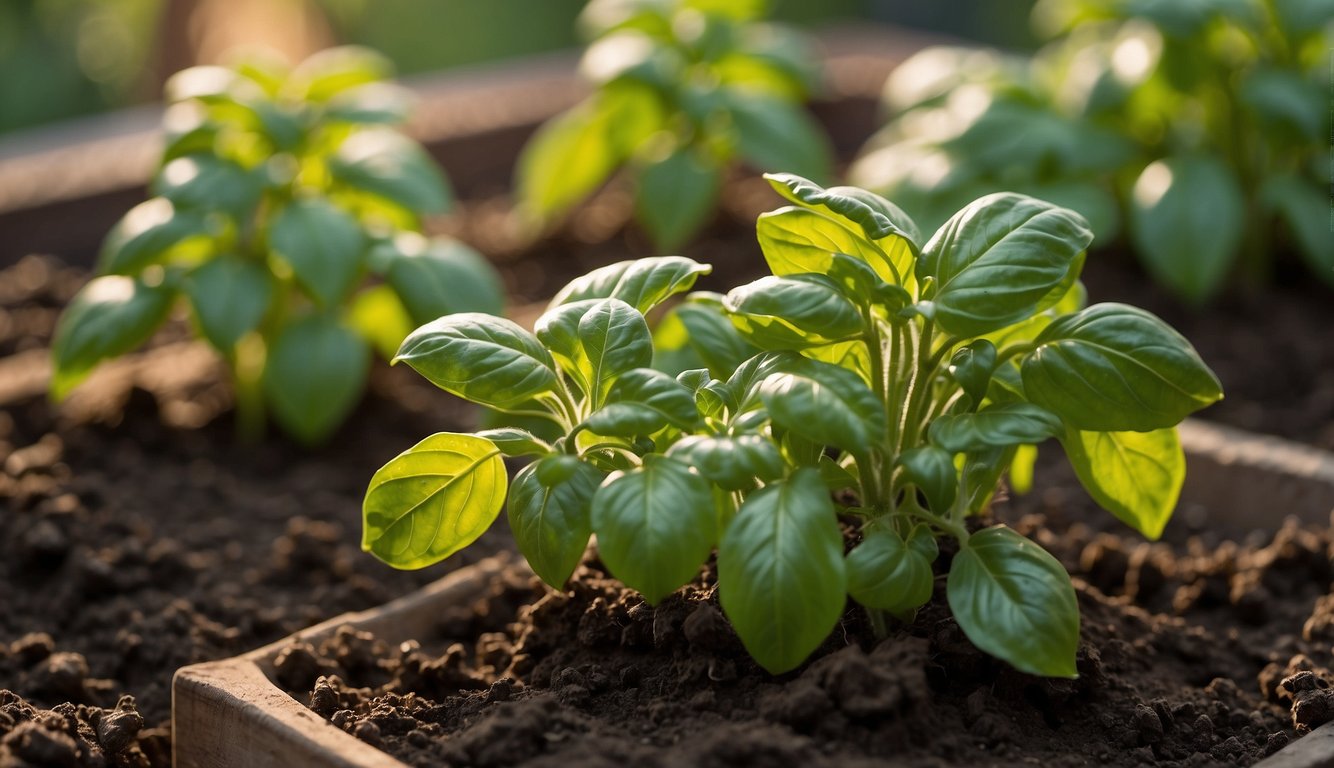
Tomatoes and Basil Companion Planting
Tomatoes and basil are considered one of the best companion plant pairings. Planting basil alongside tomatoes can help repel pests that attack tomato plants, such as tomato hornworms. Basil also enhances the flavor of tomatoes when planted nearby. Additionally, tomato plants produce solanine, which deters pests from destroying both crops. I always plant basil as a ground cover between my tomato plant rows.
Companions for Pest Management
Companion planting can help control pests in your garden. Marigolds, nasturtium, garlic, and chives are all great companions for basil and tomato plants. Marigolds repel whiteflies and spider mites, while nasturtium deters aphids. Garlic and chives repel a variety of pests, including aphids, carrot flies, and spider mites.
Companions for Soil Health
Companion planting can also help improve soil health. Asparagus and beans are great companions for basil and tomato plants as they add nitrogen to the soil. Carrots are also a great companion as they help break up the soil, allowing for better water and nutrient absorption. Adding organic matter to the soil, such as compost or aged manure, can also help improve soil health and benefit all plants in the garden.
In conclusion, planting basil and tomatoes together is a great way to enhance the flavor of your tomatoes and help control pests. Companion planting can also help improve soil health and increase crop production. By choosing the right companions for your basil and tomato plants, you can create a thriving garden that is both beautiful and productive.
Caring for Your Companion Plants – Basil and Tomato Companion Planting
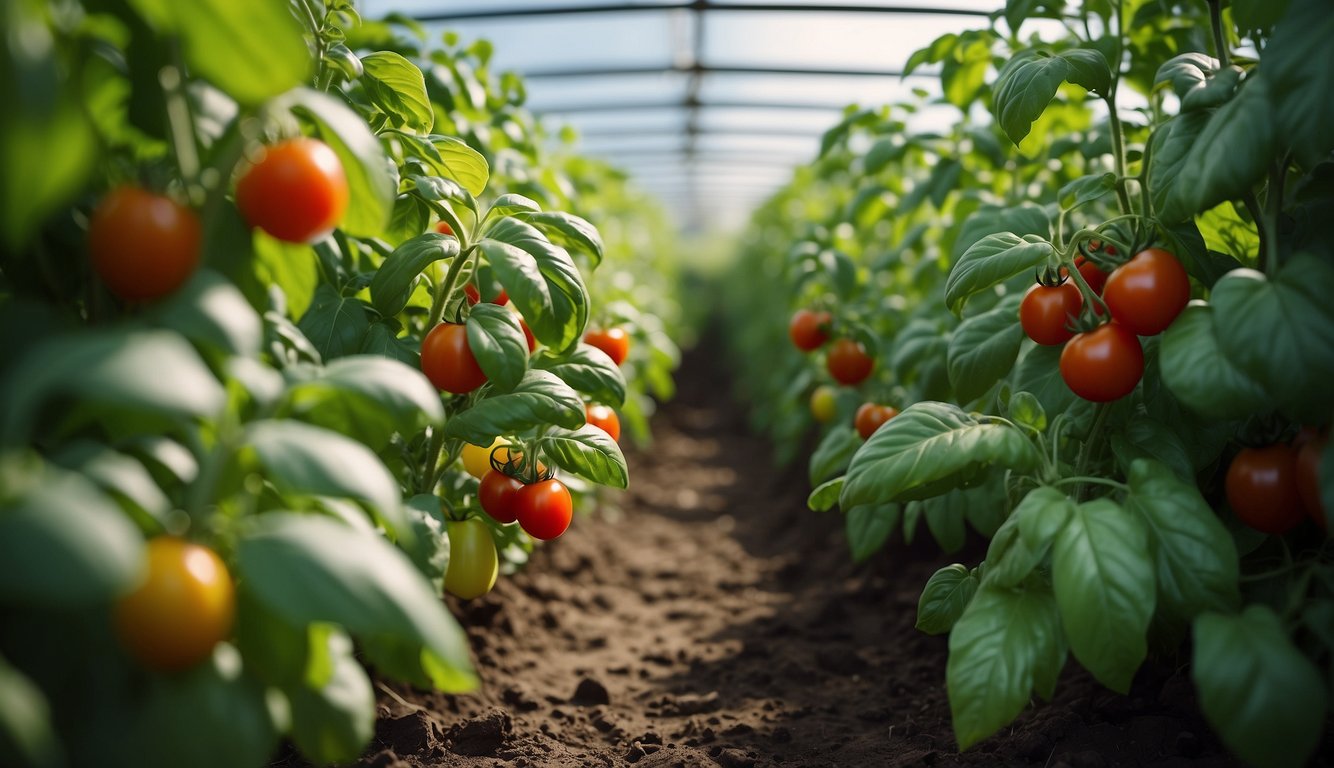
When it comes to companion planting, caring for your plants is crucial to ensure a healthy and fruitful garden. Here are some tips on how to care for your basil and tomato plants:
Watering and Feeding – Basil and Tomato Companion Planting
Watering and feeding your plants is essential for their growth and nutrient uptake. Basil and tomato plants require regular watering, especially during hot and dry weather. It is recommended to water them deeply once a week, rather than shallow watering more frequently. This encourages deeper root growth and helps the plants withstand drought conditions.
In terms of feeding, organic matter such as compost or well-rotted manure can be added to the soil before planting. Additionally, a balanced fertilizer can be applied every two to three weeks during the growing season to ensure optimal growth and health.
Pruning and Harvesting
Pruning your basil and tomato plants can help increase airflow and sunlight exposure, which can reduce the risk of diseases and improve overall plant health. For basil, pinch off the top leaves and stems regularly to encourage bushier growth and prevent the plant from going to seed too quickly. For tomatoes, remove any suckers that grow between the main stem and the branches to focus the plant’s energy on fruit production.
Harvesting your basil and ripe tomatoes regularly is also important to ensure continued growth and production. For basil, harvest the leaves as needed, making sure not to remove more than one-third of the plant at a time. For tomatoes, pick them when they are fully ripe and have a slight give when gently squeezed.
Monitoring for Pests and Diseases
Garden pests and diseases can be a major problem for basil and tomato plants. To prevent infestations, consider planting trap crops such as marigolds or nasturtiums, which can attract insect pests away from your main crops.
Regularly inspect your plants for signs of garden pests and diseases, such as yellowing leaves or wilting. If you notice any issues, remove and dispose of affected plant material immediately to prevent the spread of disease.
In summary, caring for your companion plants requires attention to watering and feeding, pruning and harvesting, and monitoring for pests and diseases. By following these tips, you can ensure a healthy and productive garden.
Companion Planting in Different Settings – Basil and Tomato Companion Planting
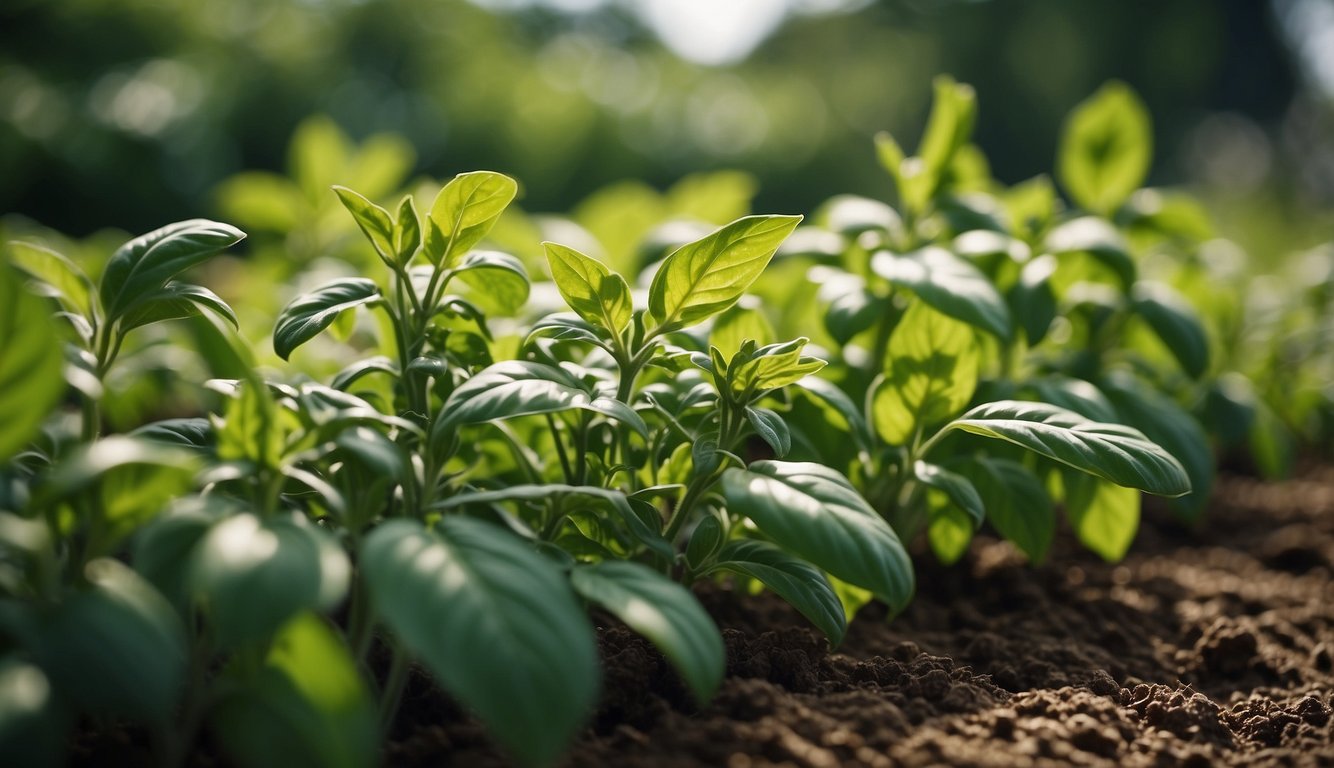
When it comes to companion planting, there are different settings that you can consider. Whether you have a small balcony garden, a raised bed, or a large farm, you can still benefit from companion planting. In this section, I will discuss how you can apply companion planting techniques to different settings.
Raised Beds and Containers – Basil and Tomato Companion Planting
If you have limited space, raised beds and containers are a great option for growing tomatoes and basil together. When planting in a raised bed, you can use a square foot gardening technique to maximize space. This technique involves dividing the bed into square sections, with each section dedicated to a specific plant. For example, you can dedicate one square to a tomato plant and another square to a basil plant. This will help you make the most of your limited space.
In containers, you can grow both tomatoes and basil together. However, you need to ensure that the containers are large enough to accommodate both plants. Tomatoes require a lot of water and nutrients, so you need to ensure that the soil in the container is rich in nutrients. Also, ensure that the container is placed in a sunny spot to ensure that both plants get enough sunlight.
Large Gardens and Farms
If you have a large garden or farm, you can use crop rotation to ensure that tomatoes and basil are not planted in the same spot year after year. Crop rotation involves planting different crops in the same spot each year to prevent the buildup of pests and diseases. For example, you can plant tomatoes in one spot one year and basil in the same spot the next year.
In a large garden or farm, you can also use companion planting to attract beneficial insects and repel harmful ones. For example, planting marigolds near tomatoes can help repel nematodes, while planting basil near tomatoes can help repel hornworms. Additionally, planting beans near basil can help enrich the soil with nitrogen, which basil needs to grow.
In conclusion, companion planting is a great way to grow tomatoes and basil together in different settings. Whether you have limited space or a large garden, you can use companion planting to maximize your yields and prevent pests and diseases.
Harvesting and Using Your Produce – Basil and Tomato Companion Planting
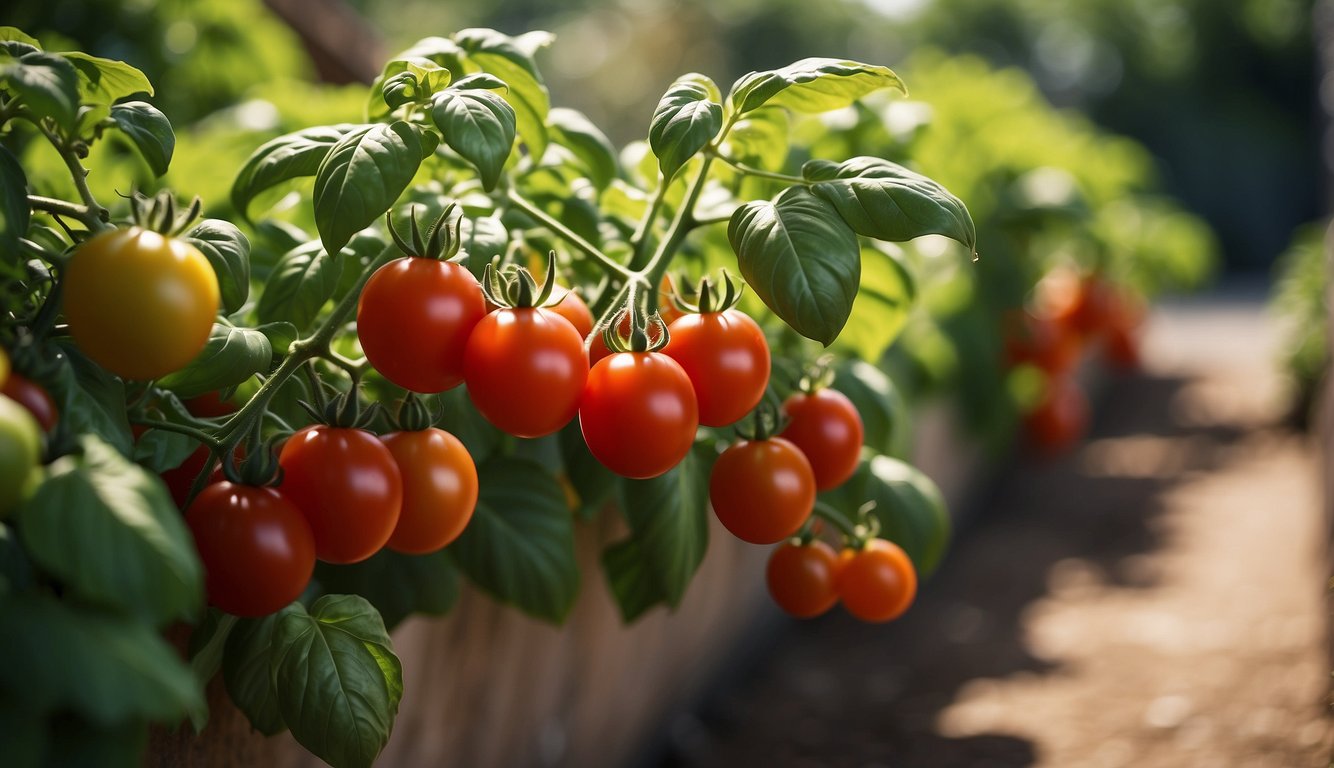
Best Practices for Harvesting
When harvesting tomatoes, it is best to wait until they are fully ripe on the vine. This allows them to develop their full flavor and sweetness. Ripe tomatoes should be firm but slightly soft to the touch. They should also have a deep, rich color and a strong tomato aroma.
Basil, on the other hand, should be harvested before it flowers. This is when the leaves contain the highest concentration of essential oils, which give the herb its flavor and aroma. When harvesting basil, it is important to pinch off the top leaves and stems, rather than cutting the plant at the base. This will encourage the plant to produce more leaves and continue growing.
Storing and Preserving – Basil and Tomato Companion Planting
Tomatoes should be stored at room temperature until they are fully ripe. Once they are ripe, they can be stored in the refrigerator for up to a week. However, refrigeration can affect the flavor and texture of tomatoes, so it is best to use them as soon as possible.
Basil can be stored in the refrigerator for a few days, but it is best to use it as soon as possible. To preserve basil for longer periods, it can be dried or frozen. To dry basil, simply hang the stems upside down in a warm, dry place until the leaves are crispy. Once dry, the leaves can be crumbled and stored in an airtight container. To freeze basil, simply chop the leaves and pack them into ice cube trays with a little water. Once frozen, the cubes can be stored in a freezer bag and used as needed.
Culinary Uses
Tomatoes and basil are a classic combination in many Italian dishes, such as Caprese salad and Margherita pizza. They can also be used in a variety of other dishes, such as pasta sauces, soups, and stews. When cooking with tomatoes, it is important to remove the seeds and skin, as they can be tough and bitter. Basil can be added to dishes either fresh or dried, depending on the recipe.
Here are a few recipe ideas to get you started:
- Tomato and Basil Bruschetta: Toast slices of bread, then top with diced tomatoes, chopped basil, and a drizzle of olive oil.
- Tomato and Basil Pasta: Cook spaghetti according to package instructions, then toss with a sauce made from sautéed garlic, diced tomatoes, and chopped basil.
- Tomato and Basil Soup: Sauté onions and garlic in a pot, then add diced tomatoes, chicken broth, and chopped basil. Simmer until the tomatoes are soft, then blend until smooth.
Basil and Tomato Companion Planting
Today, we’re exploring the beautiful friendship between basil and tomatoes in the garden. Get ready, it’s going to be a blooming ride!
Firstly, let’s talk about companion planting. It’s the idea that certain plants grow better together. It’s like a garden party where everyone’s invited!
Now, the basil and tomato combo. These two are best buds in the garden. Basil helps repel pests that love to munch on tomatoes. It’s like a personal bodyguard for your tomatoes!
And here’s a fun fact! Some gardeners believe that growing basil near tomatoes can even improve their flavor. It’s like a flavor boost right from the garden! You can check our homepage here.
So, next time you’re planning your garden, why not plant some basil next to your tomatoes? They’ll thank you for it!
For more companion planting tips, do visit the website theherbprof.com. Keep it growing, folks!
References – Basil and Tomato Companion Planting
Little Herb Encyclopedia, by Jack Ritchason; N.D., Woodland Publishing Incorporated, 1995
The Ultimate Healing System, Course Manual, Copyright 1985, Don Lepore
Planetary Herbology, Michael Tierra, C.A., N.D., Lotus Press, 1988
Handbook of Medicinal Herbs, by James A. Duke, Pub. CRP Second Edition 2007
The Complete Medicinal Herbal, by Penelope Ody, Published by Dorling Kindersley
Check the Following Articles!
Weird Vegetables to Grow: Unique and Uncommon Varieties
Feeding Tomatoes: Tips for Optimal Growth
How to Use Coffee Grounds in Potted Plants?
Frequently Asked Questions – Basil and Tomato Companion Planting

How many basil plants should be planted per tomato plant for optimal growth?
It is recommended to plant one to two basil plants for each tomato plant. This ratio ensures that the basil does not compete with the tomato plant for nutrients and space. However, the exact number of basil plants can vary based on the size of the container or garden bed.
What are the benefits of planting basil alongside tomatoes?
Basil and tomatoes are natural companions in the garden. Basil can help deter pests that commonly attack tomato plants, such as aphids and tomato hornworms. Additionally, basil can improve the flavor of tomatoes when grown together. Basil also provides shade and moisture retention for the soil, which can benefit tomato plants.
Can basil and tomatoes be planted together in containers, and if so, how?
Yes, basil and tomatoes can be planted together in containers. It is recommended to use a large container to allow for proper root growth and to ensure that the plants do not compete for space. When planting, place the tomato plant in the center of the container and surround it with basil plants. Ensure that the container has adequate drainage and is placed in a location that receives at least six hours of sunlight per day.
What other vegetables work well as companion plants with basil and tomatoes?
Other vegetables that work well as companion plants with basil and tomatoes include peppers, eggplant, and garlic. Peppers and eggplant are in the same family as tomatoes, so they have similar nutrient requirements and can benefit from the same soil conditions. Garlic can help deter pests and diseases that commonly affect tomato plants.
What are some common pests that basil can help deter when planted near tomatoes?
Basil can help deter a variety of pests that commonly affect tomato plants, including aphids, tomato hornworms, and whiteflies. The strong scent of basil can also help mask the scent of the tomato plant, making it less attractive to pests.
Are there any plants that should be avoided when practicing companion planting with basil and tomatoes?
Plants that should be avoided when practicing companion planting with basil and tomatoes include fennel and brassicas, such as broccoli and cabbage. These plants can release chemicals that can inhibit the growth of nearby plants, including tomatoes and basil.
